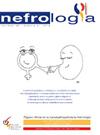尿分流患者伴SGLT2抑制剂的严重高氯血症代谢性酸中毒
IF 2
4区 医学
Q2 UROLOGY & NEPHROLOGY
引用次数: 0
摘要
自体肠段膀胱切除术后尿改道已成为几种泌尿系统疾病的金标准治疗方法。最常见的代谢后果是高氯血症代谢性酸中毒,这是由于吸收氢铵和氯离子以换取在肠管中排泄碳酸氢盐和钠离子。钠-葡萄糖共转运蛋白-2 (SGLT2)抑制剂是一类抗高血糖药物,可阻断肾近曲小管中过滤葡萄糖的重吸收,促进尿中葡萄糖和钠的更多排泄。作者描述了两例患者在开始使用SGLT2抑制剂后,患有肠导管和轻度/重度高氯血症代谢性酸中毒。两例患者均表现为轻度急性肾损伤,中度高血糖,酮酸、乳酸、阴离子间隙正常。停用该药并给予液体支持治疗后,达到临床和实验室标准。我们假设SGLT2抑制剂可能会加重这些患者的慢性高氯血症代谢性酸中毒,通过增加钠流失和容量消耗,随后的急性肾损伤(AKI),增加由于钠流失导致的肾脏氯化物消除和随后的氯化物/碳酸氢盐肠交换。通过抑制Na+−H+交换物3 (NHE3),肠道吸收和碳酸氢盐肾脏消除引起的反跳性高血糖也可能起作用。这种联系需要进一步调查。本文章由计算机程序翻译,如有差异,请以英文原文为准。
Severe hyperchloremic metabolic acidosis with SGLT2 inhibitors in patients with urinary diversion
Urinary diversion after cystectomy using autologous intestinal segments has been the gold standard treatment in several urinary tract diseases. The most frequent metabolic consequence is hyperchloremic metabolic acidosis, due to ammonium hydrogen and chloride ions absorption in exchange for the excretion of bicarbonate and sodium ions in the bowel conduit.
Sodium-glucose co-transporter-2 (SGLT2) inhibitors are a class of antihyperglycemic agents that block the reabsorption of filtered glucose in the renal proximal convoluted tubules, promoting greater urinary glucose and sodium excretion.
The authors describe two cases of patients with bowel conduit and mild/severe hyperchloremic metabolic acidosis, after starting SGLT2 inhibitors. Both were presented with mild acute kidney injury, moderate hyperglycemia, normal ketoacids, normal lactate and normal anion gap. Clinical and laboratory normalization were reached after this drug was withdrawn and fluid support therapy was applied.
We hypothesize that SGLT2 inhibitors could exacerbate chronic hyperchloremic metabolic acidosis in these patients, by enhance sodium loss and volume depletion, subsequent acute kidney injury (AKI), increase renal chloride elimination due to sodium loss and subsequent chloride/bicarbonate bowel exchange. Rebound hyperglycemia due to bowel absorption and bicarbonate renal elimination through Na+−H+exchanger 3 (NHE3) suppression, could also contribute. This association needs further investigation.
求助全文
通过发布文献求助,成功后即可免费获取论文全文。
去求助
来源期刊

Nefrologia
医学-泌尿学与肾脏学
CiteScore
3.40
自引率
7.70%
发文量
148
审稿时长
47 days
期刊介绍:
Nefrología is the official publication of the Spanish Society of Nephrology. The Journal publishes articles on basic or clinical research relating to nephrology, arterial hypertension, dialysis and kidney transplants. It is governed by the peer review system and all original papers are subject to internal assessment and external reviews. The journal accepts submissions of articles in English and in Spanish languages.
 求助内容:
求助内容: 应助结果提醒方式:
应助结果提醒方式:


